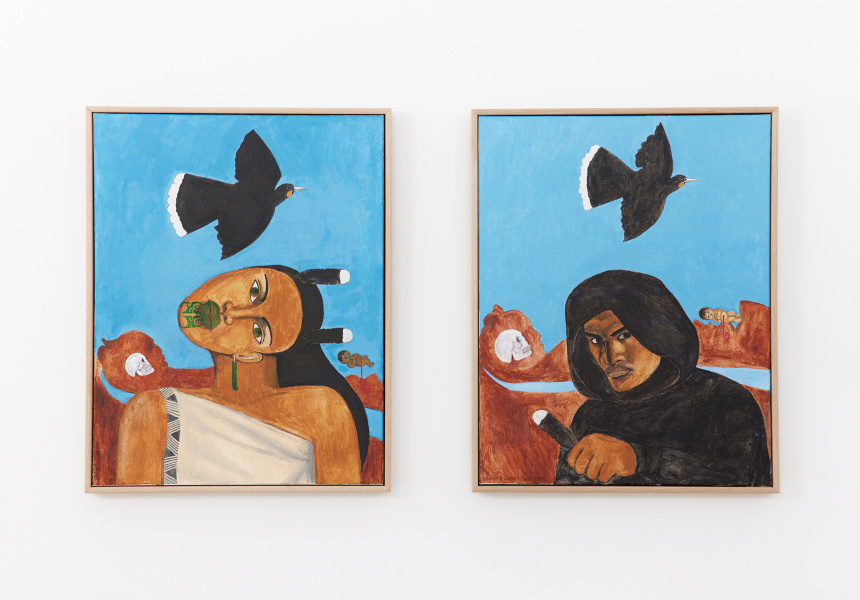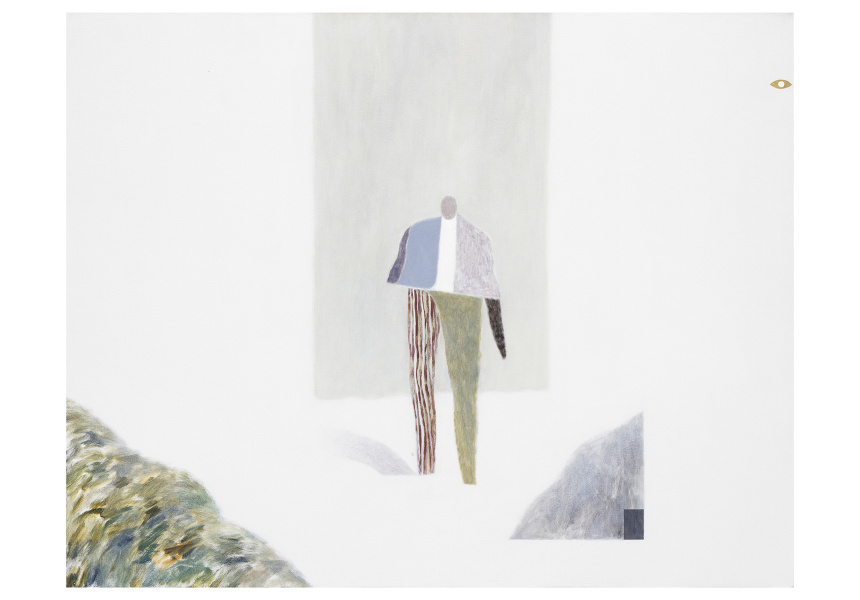Robyn Kahukiwa: Mana Māori Motuhake
The phrase “mana motuhake” has several meanings, all of which revolve around self-governance, autonomy, independence and authority. It’s a fitting concept for this solo show by significant Māori artist Robyn Kahukiwa (Ngāti Porou, Te Atianga-a-Hauiti, Ngati Konohi, Whanau-a-Ruataupare), who has long been celebrated for how she combines art with politics. With this new collection of paintings, the 84-year-old continues to fiercely express her dedication to Māori sovereignty and political activism.
The exhibition includes three series. All feature her recognisable and striking portraiture style, albeit in different ways. The Sovereign Māori Nations works use text to proclaim “return stolen lands” and urge honouring of the Treaty of Waitangi. The slightly surreal Pepeha paintings portray figures against a landscape loaded with symbolism and motifs, highlighting the importance of whakapapa (lineage) and the promise of rangatahi (the younger generation). Three more paintings echo Kahukiwa’s 1980s series Wāhine Toa (which generally means strong or brave women). Each allegorical portrait embodies Kahukiwa’s enduring commitment to platforming the experiences of wāhine Māori (Māori women).
Until October 1 at Season, Commercial Bay, 6 Lower Albert Street, Auckland CBD. Free.
Never miss a moment. Make sure you're subscribed to our newsletter today.
SUBSCRIBE NOWClaudia Kogachi: Blue Moon
Auckland-based artist Claudia Kogachi’s profile is on the rise, and she’s off to Brisbane this month for a residency at Artisan Queensland. Her last exhibition before she leaves, and her first at Karangahape Road’s Melanie Roger Gallery, Blue Moon features a cast of spooky icons.
For Blue Moon, Kogachi has used oil pastels for the first time (she usually uses acrylics) to create bold, cartoonish studies of haunted forests, smirking suns, and a vampire playing backgammon with a wolf – all of which set the scene for Kogachi’s fantastical world. The artist often bends the limits of fiction, inserting both herself and the people in her life into her art. This time, she’s trying the supernatural on for size in what could be thought of as the Halloween special of the Kogachi visual universe. Somewhere between the roaring fire and a rat gazing at the moon, she appears as twin mermaids whose tails curl into a love heart. In another work, she’s a trio of centaurs in blood-red string bikinis.
Until September 17 at Melanie Roger Gallery, 444 Karangahape Road, Newton, Auckland. Free.
Ayesha Green: Folk Nationalism
Auckland-based Ayesha Green’s (Ngāti Kahungunu, Kai Tahu) paintings are deceptively simple. With their blocks of colour and flattened figures, these works project a naivety that disguises their depth of meaning. Her new series, Folk Nationalism, is showing at Tauranga Art Gallery Toi Tauranga and in it, she unpacks the construction of national identity, continuing to question how Māori and Pākehā are represented in art and imagery. Her paintings ask what stories we recall from our collective past and how they inform our lives today.
Green adopts existing historical imagery, such as Marcus King’s 1938 painting of the signing of the Treaty of Waitangi, and makes subtle changes that unsettle our understanding of it. Compositions are inverted, contextual elements go missing, and unexpected objects appear like a game of spot-the-difference. In Self Portrait as Joseph Banks, she co-opts a portrait by Benjamin West. Here she enters the frame herself, disrupting the fabric of our colonial past with her presence.
Until January 22, 2023, at Tauranga Art Gallery Toi Tauranga, Cnr Wharf and Willow Streets, Tauranga. Free for NZ residents, $7 for international visitors over 13 years old.
Alan Ibell: A New Mountain
In his new series showing at Wellington’s Jhana Millers Gallery, painter Alan Ibell explores the mountain as a place of enlightenment. In myths and fables, mountains often offer self-knowledge; when the hero descends, they are forever changed. In Ibell’s pastel dreamscapes, the mountains are occupied by his signature solitary wanderers, portals and ghostly doubles. While they’re familiar as human figures, they lack recognisable features, which gives them a surreal quality.
Within his seven works, Ibell’s mountains fracture and distort – sometimes dominating the frame, sometimes succumbing to a dark and starless sky (that might also be a black void). His protagonists search for meaning but his work offers no answers, with the desolate landscapes inviting your own musings as you move between the canvases.
September 15 – October 8, 2022, Jhana Millers Gallery, Level 1/85 Victoria Street, Wellington. Free.



